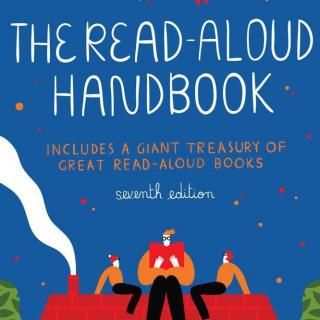
介绍:
Chapter 1 Why Read Aloud? 《朗读手册》第一章 为什么要朗读
Education is not the filling of a bucket but the lighting of a fire.
—William Butler Yeats
教育不是注满一桶水,而是点燃一把火。
——叶芝
Every child begins school wanting to learn to read. In other words, we’ve got 100 percent enthusiasm and desire when they start school—the first chapter in their life.
每个孩子在开始上学时都想学习如何阅读。换句话说,孩子刚上学时,对阅读有着百分之百的热情与渴望。
In subsequent years, when the National Reading Report Card surveyed students, they found very different attitudes and behavior as the students aged: 几个月后,“全美阅读报告卡”(the National Reading Report Card)告诉大家接下来的事实:
Among fourth-graders, only 54 percent read something for pleasure every day.
Among eighth-graders, only 30 percent read for pleasure daily.
By twelfth grade, only 19 percent read anything for pleasure daily.
在四年级学生中,45.7%的孩子每天会将阅读当成休闲活动。
在八年级学生中,只有27%的孩子为了兴趣而阅读。
到了十二年级,只有24.4%的孩子每天享受阅读的乐趣。
Think about it: We have 100 percent interest in kindergarten but lose three quarters of our potential lifetime readers by the time they’re eighteen.
幼儿园儿童百分之百对阅读感兴趣,但到了18岁,我们失去了3/4潜在的终身阅读者。
Any business that kept losing that much of its customer base would be out of business.
任何企业若不断流失大批消费者,都将面临破产。
Admittedly there is a natural falloff during adolescence and early adulthood—these are the busiest social and emotional times of human life. But what if the early interest never returns?
然而,无可否认的是,在青春期和成年初期我们对阅读的兴趣会自然下降。因为这是人生中最忙碌的社交和情感时期。但如果最初的兴趣不在回来了怎么办?
If schooling’s objective is to create lifetime readers who continue to read and educate themselves after they graduate and then they fail to do so, that’s a major indictment of the process.
学校的教学目标应该是培养出终身的阅读者,培养那些在毕业后仍坚持阅读与学习的人。但学生并没有成为那样的人。这就是对学校教育最严厉的控诉。
So How Do We Fix the Reading Problem? 我们怎样改善阅读问题?
美国阅读委员会于1985 年发布了一项名为《成为阅读大国》(Becoming a Nation of Readers)的报告。在主要的研究结果中,有两项简单的论述很震撼人心:
“The single most important activity for building the knowledge required for
eventual success in reading is reading aloud to children.”
建立孩子必备的知识体系,引导他们最终踏上成功的阅读之路。唯一且最重要的方式就是为孩子大声朗读。
“It is a practice that should continue throughout the grades.” The commission found conclusive evidence to support reading aloud not only in the home but also in the classroom.
“朗读应该在各年级都进行。”证据显示,朗读不只在家庭中有效,在课堂里也成果非凡。
And how exactly does a person become proficient at reading? It’s a simple, two-part formula: 阅读能带来什么好处?一切都可归纳为一则简单的两个层次的公式:
The more you read, the better you get at it; the better you get at it, the more you like it; and the more you like it, the more you do it.
你读得越多,理解力越好,理解力越好,就越喜欢读,就读的越多。
The more you read, the more you know; and the more you know, the smarter you grow.
你读的越多,你知道的越多,你知道的越多你就越聪明。
As lumber is the primary support for building a house, words are the primary structure for learning.
There are really only two efficient ways to get words into a person’s brain: either by seeing them or by hearing them.
字词是学习的基础,让人的大脑记住字词只有两个有效途径,一是看,二是听,
Since it will be years before an infant uses his or her eyes for actual reading, the best source for vocabulary and brain building becomes the ear.
婴幼儿需要很多年才能学会用眼睛进行真正的阅读,因此,学习字词的最佳途径就是听,
What we send into that ear becomes the foundation for the child’s “brain house.”
Those meaningful sounds in the ear now will help the child make sense of the words coming in through the eye later when learning to read.
听进去的东西,才能成为儿童大脑无物的基础,但孩子们之后,通过眼睛学习阅读时,这些有意义的声音,可以帮助他们理解单词的含义。
We read to children for all the same reasons we talk with children: to reassure, to entertain, to bond, to inform or explain, to arouse curiosity and to inspire.
读书给孩子听,就像跟孩子谈话,同样是为了,安慰孩子,带来欢笑。拉近彼此的距离,向孩子说明或解释问题,引发孩子的好奇心,激励孩子。
But in reading aloud, we also:在朗读中我们还可以,
build vocabulary建立词汇基础,
condition the child’s brain to associate reading with pleasure
在孩子的脑中,将阅读与愉悦联系在一起。
create background knowledge创造背景知识,
provide a reading role model树立一个阅读的典范,
plant the desire to read 植入阅读的渴求。
大家还在听

